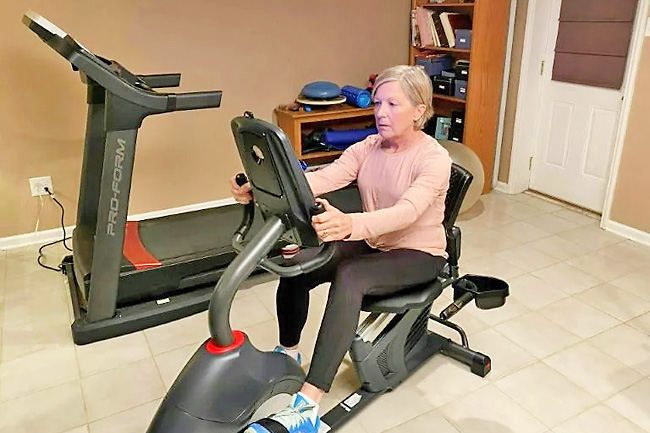WASHINGTON (AFP) – When Stephanie Hedrick realised she was still suffering from shortness of breath, blurry vision and brain fog months after recovering from COVID-19, she knew she needed more help than her primary care doctor alone could provide.
“Not every doctor knows everything,” said the 62-year-old, a retired teacher from the United States (US) state of Virginia.
After months of rehabilitative therapy at a specialised clinic in the nearby capital Washington, Hedrick was finally able to play in the waves with her five grandkids this summer.
The MedStar COVID Recovery Programme that she turned to is part of a new wave of clinics specifically treating patients suffering from long COVID – a post-infection syndrome that can affect nearly every system in the body, causing sometimes debilitating symptoms.
“The clinic gave me hope that life was going to go on,” Hedrick said.
Similar clinics have popped up across the US as thousands of people who recovered from coronavirus infections – even mild ones – found themselves still struggling.
Doctors have known for years that some patients who recover from viral infections go on to develop post-viral syndromes, but the exact cause is unknown. “There’s something happening. It’s very clearly not in people’s heads,” COVID-19 Recovery Clinic with the George Washington University health system Co-Director Hana Akselrod said.

Estimates of long COVID’s prevalence vary widely from study to study, from as little as 10 per cent of people who recover from a COVID infection, to as high as 35 or even 50 per cent.
After her infection, Hedrick – who described herself as otherwise “active” – was suddenly having irregular heart rhythms, joint pain and shortness of breath.
“It’s like somebody took your energy and strength and motivation to be able to do something,” she said.
MedStar Clinic Head Eric Wisotzky said he works with patients on strategies to manage their complaints – a “delicate balance” of exercise and rest.
Some even regain a lost sense of smell through a regimen of sniffing essential oils several times a day.
To improve endurance, Hedrick was advised to do short, easy exercises.
And when she gets confused at the grocery store, Hedrick uses the strategies her speech therapist taught her, to slow down and go through her shopping list item by item.
She admitted she didn’t feel totally back to normal.
But, “I have longer periods of good days”, she said.
Johns Hopkins Post-Acute COVID-19 Team in Baltimore, Maryland Co-Director Alba Azola said she has “multiple theories” about what causes long COVID, from bits of virus remaining in the body to an out-of-whack immune system.
“I think that there’s more than one mechanism at play and we just need to catch up with the science,” Azola said.
The US Centers for Disease Control and Prevention (CDC) define long COVID as a collection of “new or ongoing” symptoms four or more weeks after the acute infection has resolved”, though there is disagreement about exactly what ailments can be attributed to the condition.
For many patients, the mere idea a doctor will acknowledge their suffering can bring relief.
Marijke Sutter, 39, is a Baltimore nurse who caught COVID in March 2020 – likely, she believes, from her job.
Sutter ended up quitting, needing more time to rest.
“That initial four months is a blur,” said Sutter said, who was plagued by fatigue and insomnia.
She began seeing the doctors at Johns Hopkins in June 2021.
“It’s nice to have doctors validate my patient experience,” Sutter said.
Sutter said meditation and yoga have been most helpful to her recovery, and is now back to work half-time, teaching nursing remotely. But she still needs three-hour naps most days.
“Cognitive functioning is just as exhausting as physical work,” she said.
Rachel Curley, a 32-year-old Washington resident and MedStar patient, also found moving to part-time work at her policy advocacy job helped her battle long COVID.
Curley became infected in December 2020. Within a few weeks, her fever was gone, replaced by extreme fatigue, brain fog and dizzy spells. Everyday tasks would cause her heart rate to spike.
“It feels on some level scary,” Curley said. “What if I don’t ever feel better?”
So far, Curley has been instructed to avoid stress, but increase physical activity – and the formula has so far helped her eliminate fatigue.
There is no one-size-fits-all cure, Hedrick explained.
“If this is the new normal, then I have a toolbox with tools, I have doctors, I have strategies and I can reach out to any of them,” she said.






